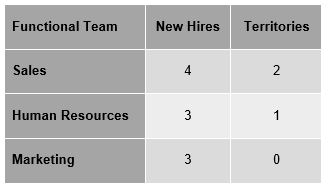End the Fighting (Over Disconnected Planning Models)
I hope no fists are flying at your office over budgeting and forecasting, however conflict is likely to occur. In this case, opinions and facts from different stakeholders can help. At the same time, impactful decisions at organizations that can affect the direction over days, months and years are derived from the better outcomes. The unnecessary part of conflict can be minimized with an integrated process letting the data drive these outcomes.

Today, communication occurs using more methods and more levels of complexity. Beyond simple discussions or email, take it a step further with transparency and integration. This will likely transform the process, the results, and even the organization. The value will grow as integration in all forms is institutionalized and embedded in the process.
Finance professionals and budget stakeholders, such as sales, marketing and HR, must work together. This is all accomplished via integrated planning. In the past we talked at each other, eventually we collaborated, and now we can be transparent and integrated.
For planning models to be effective, functional groups beyond finance need to have a hand in their creation. In most cases, people will only feel accountable to a forecast that they understand and helped create. In a collaborative planning process, finance will often have to play the role of consensus builder and chief arbiter. Take the example of a growth-oriented medical device company expanding into new territories:
- In the coming quarter, Sales Management decides they need four new sales people to support two new territories
- Human Resources is managing to the prior forecast, which included sales people and one new territory
- Marketing is not preparing for new territory segmentation and demand generation because they are managing to the original budget set late last year

There is a mismatch. Not only will the budget be incorrect, but the departments will not be working together…finance is left to become a “reconciler in chief” to consolidate the models.
Automating and integrating these segregated models provides value:
- Create more time for all to focus on core strategy and analysis
- Ad Hoc requests include latest data
- Finance can support the buyer’s journey properly
How Do We Start?
First, make sure planners are focused on the real drivers that will affect Sales, Marketing, HR and Operations – the key demand generator for all these resources. This is specific to your industry and sometimes your company – new products, price changes, named accounts, marketing initiatives or others; foremost, the company strategy.
Next, determine the effects on your business. Will you grow in specific channels? Where will you increase capacity and what is the affect? Then trace the effects down to department. The drivers cause new hiring, additional marketing spend or increased support needs pre and post-sale of your product or service.
Finally, integrate these decisions and drivers across the functions. This goes beyond collaborating as a team. The drivers must be centralized and integrated across the individual functions. Centralized does not mean exclude stakeholders from any step. Whether your process is top down or bottom up, the business strategy comes first and then you collaborate and communicate through the integrated process.
Automating and integrating does not have to be an overnight transformation. When possible, transformation can be fast, but other times iterative steps are necessary. Ironside can help you explore the “what” and “how” for your organization to automate and integrate in a way that fits.

We’ll learn to crawl, walk, run…we work with clients at each stage and jump together!
This is just the beginning of automation and integration. With each step, the value creation grows. Collaborate on drivers, allow each stakeholder to integrate their needs and roles, then focus on the analysis versus reconciling and combining models. Stop acting like the “reconciler in chief” and add more value today.
About Ironside
Ironside was founded in 1999 as an enterprise data and analytics solution provider and system integrator. Our clients hire us to acquire, enrich and measure their data so they can make smarter, better decisions about their business. No matter your industry or specific business challenges, Ironside has the experience, perspective and agility to help transform your analytic environment.






